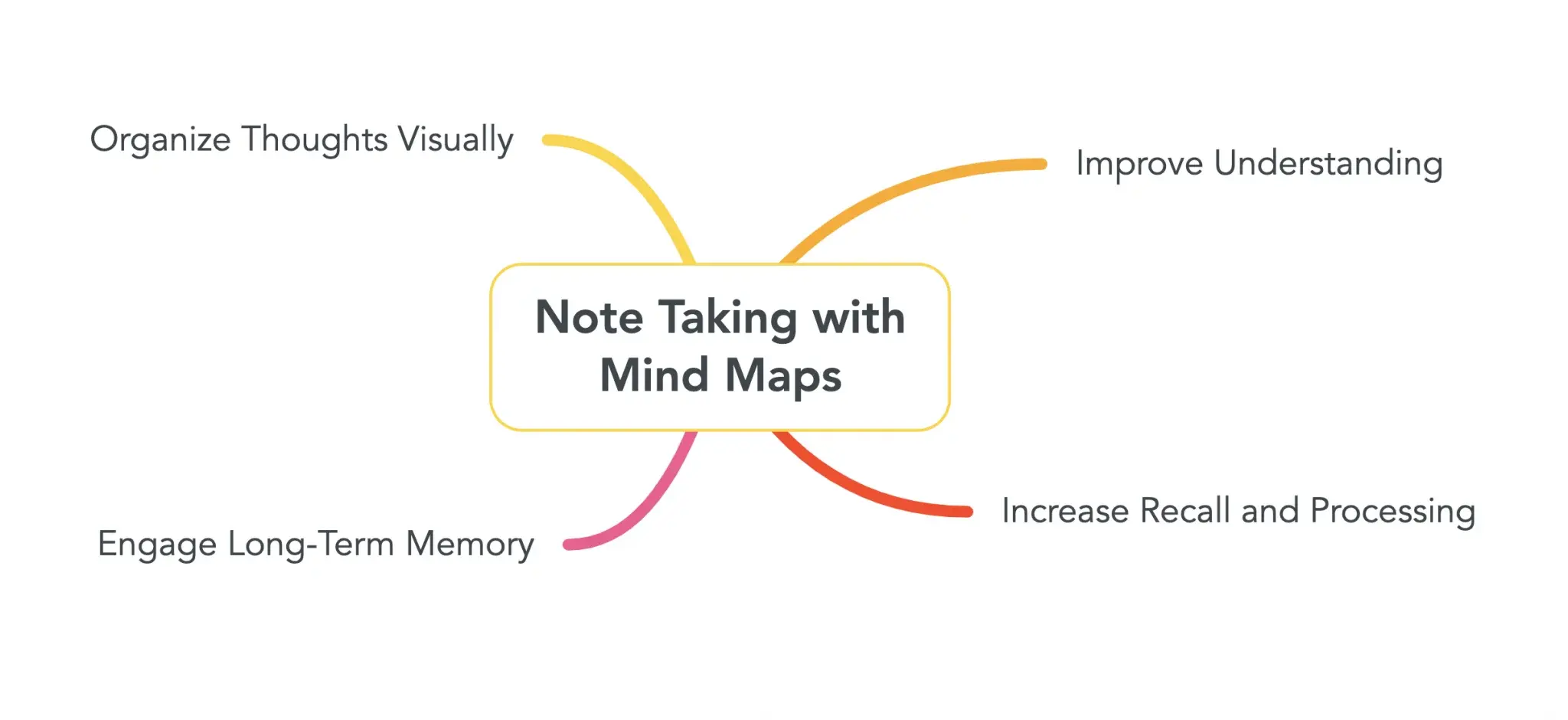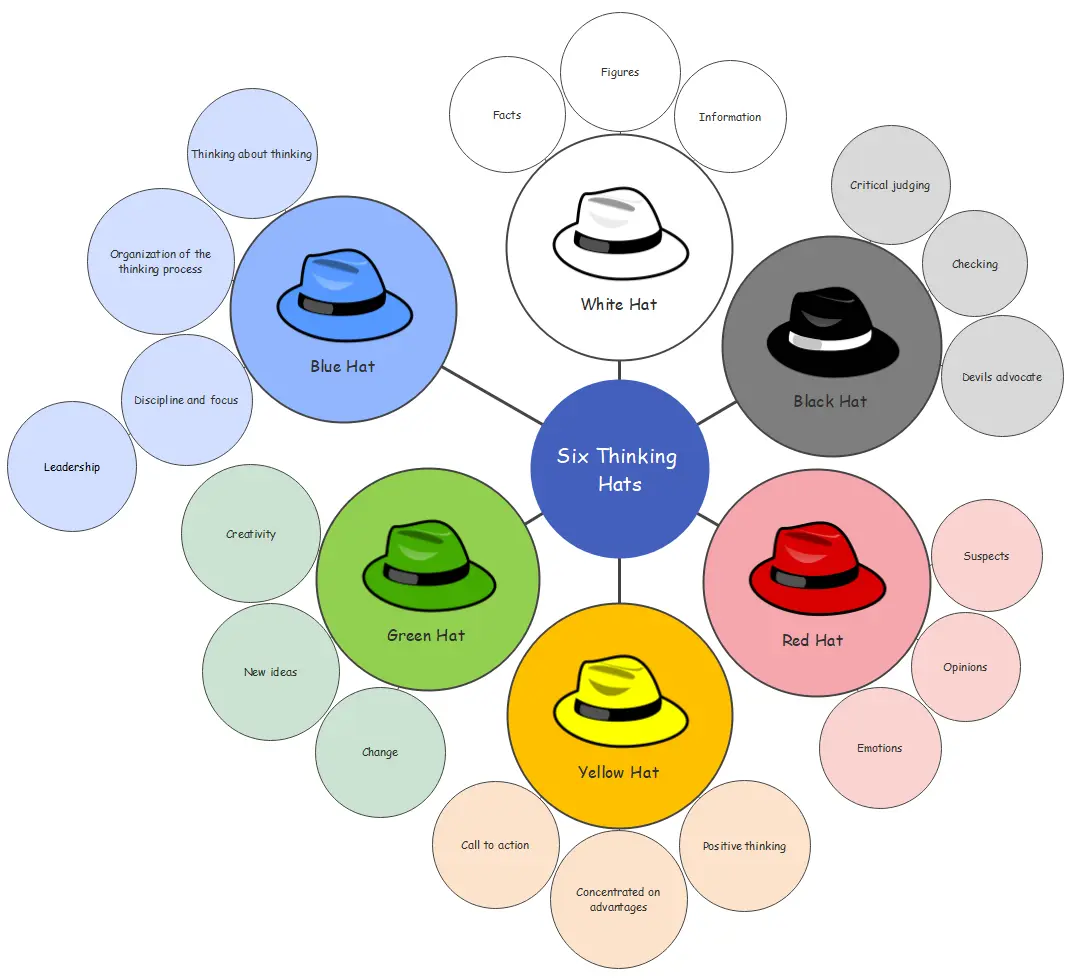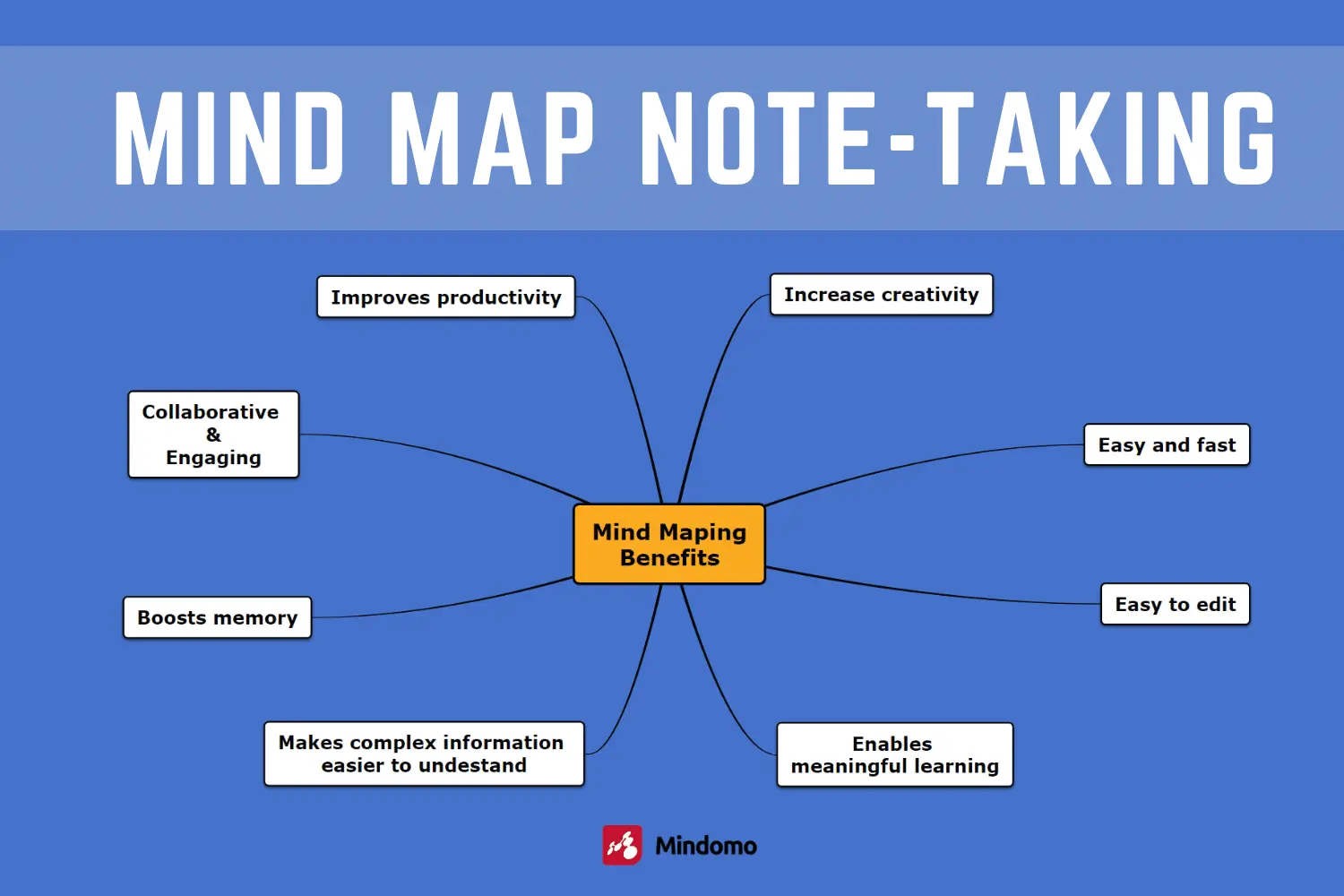Recently, effective decision-making is crucial for success in both personal and professional contexts. One powerful method to improve decision-making is the combination of the Six Thinking Hats technique with mind mapping. This blog will explore the Six Thinking Hats framework, the benefits of using this approach, an overview of mind maps, and how to effectively use Six Thinking Hats mind maps to make better decisions.
What is ‘The Six Thinking Hats’?
The Six Thinking Hats is a decision-making framework developed by Edward de Bono that encourages parallel thinking. Each “hat” represents a different perspective or approach to a problem:
- White Hat: Focuses on facts and information. It encourages participants to look at the data available and identify what information is needed to make a decision.
- Red Hat: Represents emotions and feelings. This hat allows individuals to express their intuitive reactions and feelings about the issue without needing to justify them.
- Black Hat: Highlights risks and challenges. It encourages critical thinking by identifying potential problems and obstacles, ensuring that all risks are considered.
- Yellow Hat: Emphasizes positivity and benefits. This hat focuses on the value and advantages of a decision, promoting optimism and constructive thinking.
- Green Hat: Encourages creativity and new ideas. It fosters brainstorming and innovation, allowing participants to explore alternative solutions and possibilities.
- Blue Hat: Manages the thinking process and ensures that guidelines are followed. This hat is responsible for organizing the discussion and ensuring that all perspectives are considered.
By wearing different hats, individuals and teams can explore a problem from multiple angles, leading to more comprehensive and balanced decision-making.
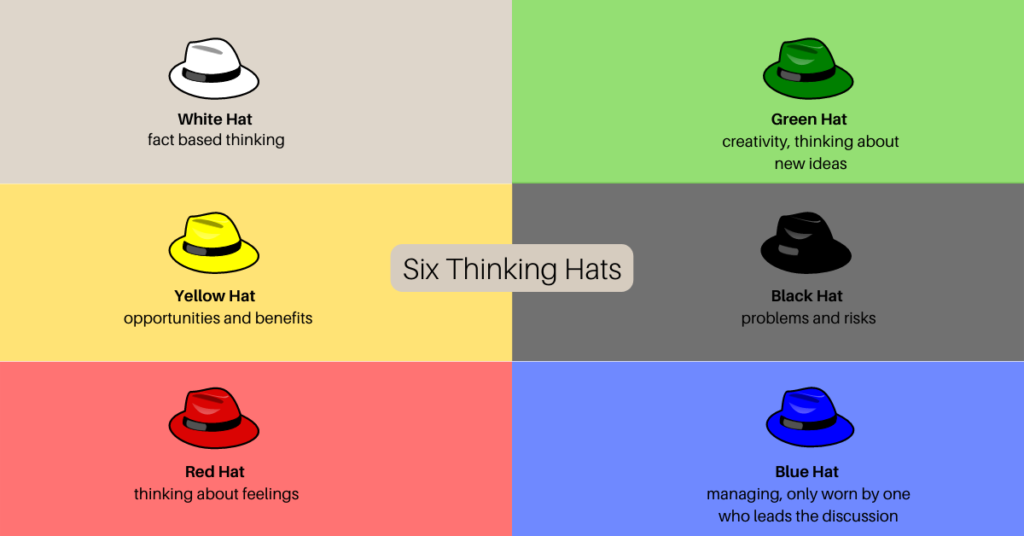
Image from: https://tsgrale.com/six-thinking-hats-make-the-right-decision/
The Benefits of Six Thinking Hats
- Structured Thinking: The Six Thinking Hats framework provides a clear structure for discussions, making it easier to navigate complex problems. Each hat directs focus on a specific aspect of the issue, ensuring that all relevant factors are considered.
- Enhanced Collaboration: By encouraging team members to adopt different perspectives, this method fosters collaboration and open dialogue. It creates an environment where everyone feels comfortable sharing their thoughts and ideas.
- Balanced Decision-Making: The framework ensures that all aspects of a problem are considered, reducing the risk of bias and oversight. This balanced approach helps teams make well-informed decisions.
- Improved Creativity: The Green Hat encourages creative thinking, helping teams generate innovative solutions. By allowing free expression of ideas, teams can explore unconventional approaches to problem-solving.
- Emotional Awareness: The Red Hat allows for the expression of feelings, ensuring that emotional factors are considered in decision-making. Recognizing emotions can lead to a deeper understanding of the motivations behind choices.
Why Use Six Thinking Hats Mind Maps for Better Decision-Making?
Combining the Six Thinking Hats technique with mind mapping offers a powerful approach to decision-making. Here are some reasons to use this combination:
- Holistic Perspective: By integrating the structured thinking of the Six Thinking Hats with the visual clarity of mind maps, teams can gain a comprehensive view of the problem. This holistic perspective ensures that no aspect is overlooked.
- Enhanced Engagement: The interactive nature of mind maps encourages participation from all team members, fostering a collaborative environment. Engaged participants are more likely to contribute valuable insights.
- Clearer Communication: Mind maps help clarify complex ideas, making it easier to communicate thoughts and perspectives effectively. This clarity is essential for productive discussions.
- Flexible Structure: Mind maps can be easily modified as discussions evolve, allowing teams to adapt their thinking in real-time. This flexibility is crucial in dynamic decision-making environments.
- Increased Creativity: The combination of structured thinking and visual organization promotes creative problem-solving and innovative solutions. This synergy enhances the overall decision-making process.

Image from: tsw.co.uk
How to Make Better Decisions with Six Thinking Hats Mind Maps
- Define the Central Problem: Start by writing the main decision or problem in the center of your mind map. This central focus will guide the exploration of different perspectives.
- Create Branches for Each Hat: Draw six branches radiating from the central problem, each labeled with one of the Six Thinking Hats. This visual layout helps organize thoughts according to different perspectives.
- Explore Each Perspective: Under each branch, brainstorm ideas and insights related to that hat’s perspective. For example:
- White Hat: Gather relevant data and facts.
- Red Hat: Note emotional responses and gut feelings.
- Black Hat: Identify potential risks and drawbacks.
- Yellow Hat: Highlight positive outcomes and benefits.
- Green Hat: Generate creative solutions and alternatives.
- Blue Hat: Summarize the discussion and outline next steps.
- Identify Relationships: Look for connections between the ideas generated under different hats. This helps in understanding how various perspectives interact and influence one another.
- Develop an Action Plan: Based on the insights gained from the mind map, create a clear action plan that outlines the steps needed to address the problem. This plan should incorporate the best ideas from each perspective.
- Review and Revise: Regularly revisit the mind map as new information emerges or as the situation evolves. This ensures that the decision-making process remains dynamic and responsive.
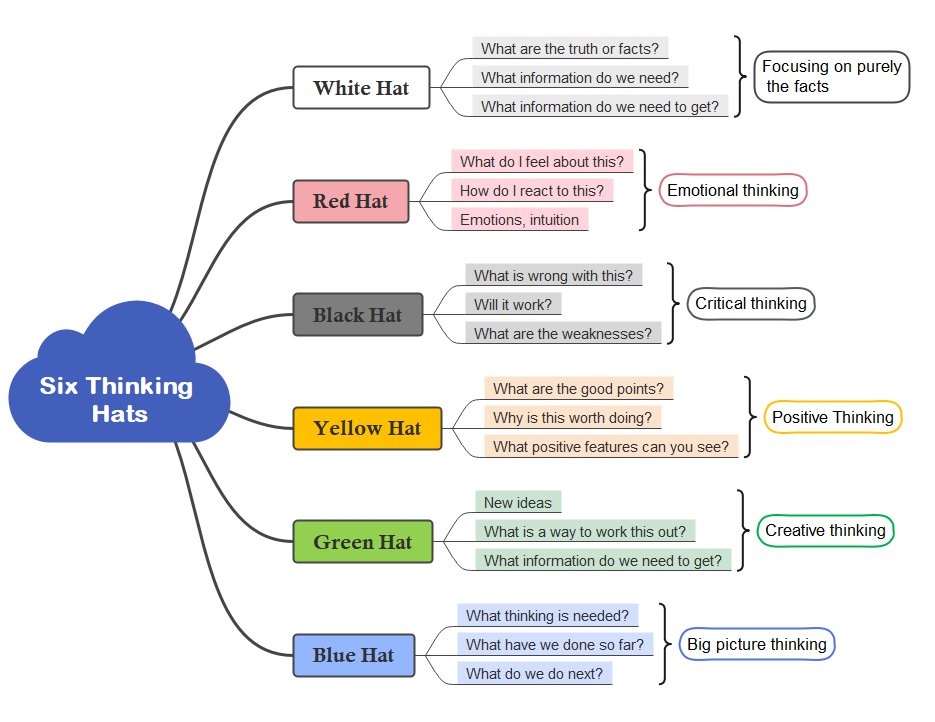
Image from: edrawmind
Example of Make Decisions with Six Thinking Hats Mind Maps ****
To illustrate how to apply the Six Thinking Hats in a real-world scenario, let’s consider the example of a coffee shop facing long wait times. The store manager, Joe, introduces the technique to his team and divides them into two groups. Each group spends six 15-minute sessions wearing a different colored hat and discussing the problem from that perspective. For instance, the White Hat focuses on facts, the Red Hat on emotions, the Black Hat on risks, and so on. After all the hats have been worn, the groups share their insights, giving the team a comprehensive view of the issue from multiple angles. This structured approach helps generate ideas and solutions while considering various factors, ultimately enabling the coffee shop to address the problem effectively.
Blue Hat
The Blue Hat focuses on the overall problem: customer complaints about long wait times. It emphasizes the need to improve customer satisfaction and outlines the benefits of solving the issue, such as enhancing the shop’s reputation and increasing business. Possible solutions include acquiring a faster coffee machine and streamlining the coffee-making process.
White Hat
The White Hat gathers factual information related to the problem. Questions include: How many complaints are received? What is the current time taken to make a coffee? Can this process be expedited? What are the costs associated with potential solutions?
Green Hat
The Green Hat encourages creative thinking and innovative solutions. Ideas may include exploring new coffee machines that operate more quickly, implementing a 5S methodology to optimize workflow, or researching what successful coffee shops are doing differently.
Yellow Hat
The Yellow Hat highlights the positive outcomes of proposed solutions. It considers how these ideas can improve speed, enhance customer satisfaction, and contribute to a better overall experience, thus justifying their implementation.
Red Hat
The Red Hat allows team members to express their gut feelings and emotional responses to the proposed ideas. It encourages discussions about potential concerns or reservations regarding the feasibility or effectiveness of the solutions.
Black Hat
The Black Hat takes a logical approach to assess the risks associated with each idea. It questions the practicality of the solutions, identifies potential pitfalls, and evaluates whether concerns raised by the Red Hat are valid.
By systematically utilizing the Six Thinking Hats, the coffee shop team can collaboratively analyze the issue from multiple perspectives, leading to a well-rounded understanding and effective solutions to improve customer satisfaction.

Image from: tsw.co.uk
Conclusion
Using Six Thinking Hats mind maps is a powerful method for enhancing decision-making. By combining the structured approach of the Six Thinking Hats with the visual clarity of mind mapping, individuals and teams can gain a comprehensive understanding of problems, foster creativity, and develop effective solutions. This approach not only improves collaboration but also leads to more informed and balanced decisions, ultimately driving success in various contexts.
